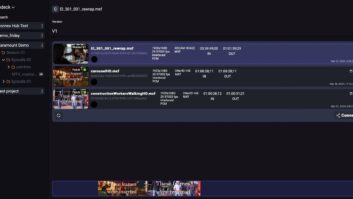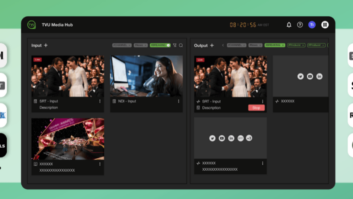
MTV networks North has pioneered an integrated content management concept, spurring other MTV facilities to follow suit. Richard Dean heads into the MTV cloud.
When Mark Knopfler added the hook line ‘I want my MTV’ to hit song Money for Nothing in 1985, he was voicing the desire of a whole generation mesmerised by the first dedicated 24/7 music video channel launched four years earlier in New York.
What he perhaps understandably didn’t point out was that delivering this series of short, disparately-sourced productions at an unprecedented rate per hour was an extremely labour-intensive and indeed expensive proposition, with an army of operatives frantically juggling individual tapes day and night.
Naturally the playout and other technology has evolved considerably over the intervening 30 years, but in 2007 MTV Networks embarked on an entirely new approach driven by Marco de Ruiter, senior VP and COO of MTV Networks North in Amsterdam; Roderick Aal, vice president Technology; and Thomas Popma, vice president Channel Operations.
Instead of independently scheduling and managing each of its six channels, MTV Networks North pioneered a Media Centre concept where all aspects of planning and content delivery were brought together for the first time. The system went live in mid 2008 with all Benelux and Scandinavian channels migrating within a year, and has since become the role model for the reorganisation of MTV Networks facilities at Camden Lock in London, which began an ambitious 18 month re-fit project in February.
At the heart of each Media Centre is the MediaGeniX WHATS’On channel management and playlist system controlling Nexus playout automation from Publitronic and a Pharos Mediator media asset management (MAM) installation. “WHATS’On provides a cockpit from which new channels can be set up and the appropriate parental guidance and bandwidth defined within a matter of hours,” explains De Ruiter.
“This is also far more efficient operationally than the old channel-based approach as all content can be shared – any person involved has access to all the information about every asset, while cumbersome middleware components have been eradicated. London in particular uses a complex legacy operation that has been glued together over 12 years, which will all be migrated across to the new system over the coming months.”
Expansion plans
Amsterdam is currently running between 25 to 30 channels – six for MTV and the rest for MTV Networks stablemates Comedy Central and Nickelodeon – with plans to expand up to around 50, while London will start with 35 to 45 but could reach as many as 60 channels as MTV’s ambitious expansion plans unfold.
Ultimately these two Media Centres will provide storage for all of MTV Networks Europe’s content, with scheduling to other regions simplified by a comprehensive rights database held within WHATS’On. With all actions taking place where the decisions are made, the single integrated system is expected to improve the overall efficiency by as much as 70%.
“An additional benefit of computerised integration is that it becomes cost-effective to programme and brand a channel even for the smallest of countries and audiences,” says Popma, adding that further efficiencies may yet emerge. “We’re working on an interface for the registration of music cues –including rights information – to streamline the assembly of content, as manually defining 200 or so cuts in a 20 minute show is a very laborious process.”
A Video on Demand (VoD) channel for delivery to cable MSOs (multiple system operator) is currently at the pilot stage in Amsterdam, and this is expected to blossom into an important element right across the entire business. MTV Networks already offers a wealth of on-demand content from a series of websites across Europe, and possible participation in the forthcoming YouView – or indeed other hybrid TV platforms – will further endorse the case for a unified multi-channel core. Again, WHATS’On will form the backbone for planning and management of all MTV Networks’ on-demand platforms, based on the same workflow and from within the same system.
According to Aal, all content is put within an MXF (Media eXchange Format) wrapper for playout, which allows a single re-usable asset to be created containing up to 18 languages plus subtitles. Metadata is kept on a database separate from the essence for ease of access, as well as to minimise bandwidth overheads.
Interestingly, ads supplied to MTV Networks now come complete with metadata – this is not the case among the broad community of music video and other programme providers, as they have yet to settle on a standard. However metadata can be directly imported from content prepared by the parent company in the US, which makes up a large proportion of MTV Networks Europe’s output.
While ad bookings are handled by a separate system, centralised channel management gives the suits plenty of stats to savour, from content management and capitalisation to extensive correlations between stocks, amortisations, ratings, product costs and the like for performing what accountants call business intelligence calculations.
The new Media Centre approach is clearly well suited to automated playout, but equally at home with live events such as MTV’s prestigious European Music Awards, says Aal. Indeed given that these events tend to air simultaneously across several regions requiring different ad breaks, he believes the process will be simplified, as all the ad breaks for each country can be executed with the press of a single button.
Although the standard definition workflow is entirely tapeless backed up with a remote storage facility in Hilversum, in the light of current workflow bandwidth constraints, HD production still takes place on tape prior to 50i/60i playout.
No other broadcaster is believed to operate a system quite like this one developed by MTV Networks. But how about what some see as the poster boy of next-generation broadcast operations – the so-called ‘cloud’ storage of content on third party servers?
“All of our content and data is stored on our own resources,” says De Ruiter. “Cloud storage could offer certain efficiencies, but as well as being secure – which is especially important in the case of high value pre-release media – it would have to be very fast to keep up with the high service levels that MTV Network output demands.
“This whole project has been about clearing bottlenecks in the system, and cloud bureaux could become a victim of their own success. With the great team that we’ve now put together at MTV Networks, I’d say that if we have to have a problem, we’d rather own it ourselves.”







